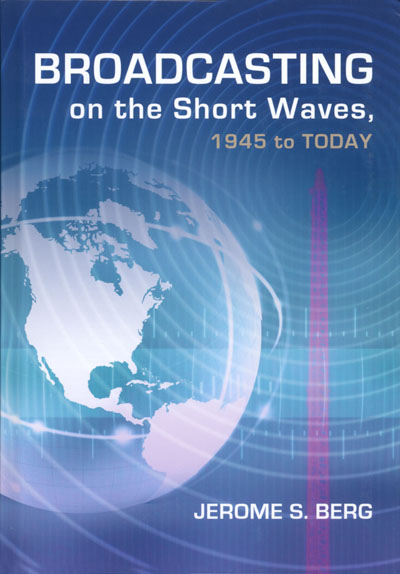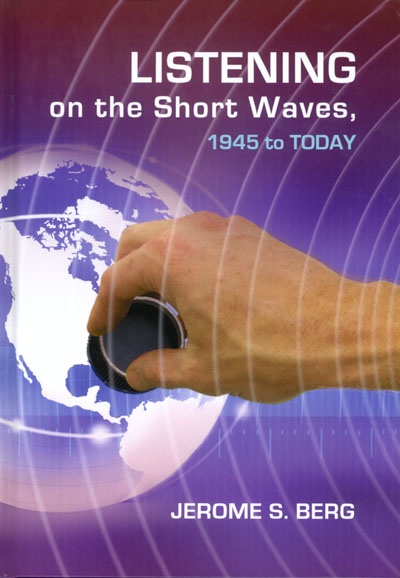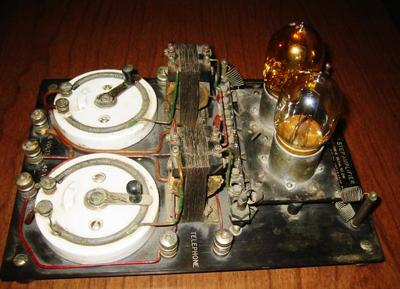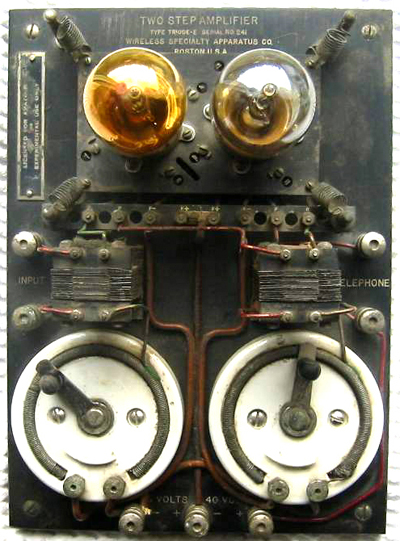Of Old Radios And Related Items--Published Monthly
BROADCASTING on the Short Waves 1945 to Today
LISTENING on the Short Waves 1945 to TodayBy Jerry Berg
Reviewed by Bart Lee
Web Edition
In 1999, Jerry Berg 's book, "On the Short Waves 1923-1945" was reviewed by Bart Lee in our September 1999 issue. Jerry has updated the shortwave story through today in his two new books, again reviewed by Bart Lee on the pages of A.R.C. (Editor)
For anyone contemplating antenna maintenance, Jerry Berg's new books are going to be enjoyable reading indeed. Jerry has now written the definitive histories of shortwave radio. The great telecommunications revolution began with "What have God Wrought?" in 1846, leading to "The Victorian Internet," as well as to the modern Internet and World Wide Web. Telephones in the 1880s added tone of voice and individual connections. Wireless telegraphy freed communications of dependence on cables. Radio carrying sound and music exploded on the world scene in the 1920s, uniting local, regional, and national areas by way of shared music from opera to folksingers, jokes, entertainment programs, and news.
The development of shortwave radio in the late 1920s, with its long distance ranges, opened the whole world to the music, news, entertainment, and propaganda of an increasingly hostile international order, soon to degenerate into war. During that Second World War, radio also played a part. Jerry Berg documented these developments fifteen years ago in his first shortwave history, On The Short Waves 1923-1945. The domestic radio mania of the 1920s translated to the international shortwave scene with enthusiasts, a popular literature, distance-dedicated DXers, program listeners, colorful QSL-cards to verify hearing the distant signals, and radio stations designed to persuade, as well as entertain.
After Jerry's history, the pressing questions for historians, as well as enthusiasts, was, "Will Jerry write again to cover post-war, cold-war and modern day shortwave radio?" Well, he has, and it's a great work. It is as complete a survey of shortwave radio as can be imagined. In two volumes, we now have LISTENING on the Short Waves 1945 to Today, and BROADCASTING on the Short Waves 1945 to Today. (Jerry is in some sense an archivist, as well as a historian, especially given his role in the leading listeners' newsletter Numero Uno since about 1970 and his founding of the QSL-Card Archive Committee to Preserve Radio Verifications (CPRV).
LISTENING re-creates the romance of hearing DX on radios that glowed in the dark (before transistors and chips); it reminds one of the pleasures of the radio magazines reporting new stations and receptions that might be achieved, and new radios to lust after. Jerry's analysis of the shortwave audience is adept. He has been an active listener since 1958, and his record of the clubs and their roles is definitive. His chapter on the literature of shortwave listening provokes nostalgia strong enough to drive one to eBay to buy some old magazines. The LISTENING book alone is a major contribution to the history and sociology of modern technology.
The companion BROADCASTING book is even better. Here one finds the stations of yesteryear, so often heard only in the dark of cold winter nights. From the BBC's empire, to radio ZQI-Jamaica, Jerry lays out just about all that can be known of these stations. His approach is year-by-year, so the arc of shortwave radio appears from its post-war renewal through its glory days to today's "just one of many media" role. Jerry's reprise of this history is a technical triumph.
It is also a pleasant reminder of the thrills of connecting to the voices, music, and personalities of the world's cities and countries. This we did most often sitting in the dark with headphones. We were oblivious to the mundane "real world" because we were living in an even more real world, far more interesting and sometimes exciting. Shortwave radio opened up a new dimension of experience. Yet one had to seek it, and train oneself in its arcane equipment, its seasonal and diurnal variations (not to mention sunspots and their effect), and learn to focus the mind on the aural not the visual.
It ain't what it used to be, of course, but then little is anymore. Still, any evening I can and do listen to the Sackville relays of the Asian stations, and the few Europeans left. Any morning the Asians fly over the Pacific until sunrise. North Korea still praises the work of the 99th People's Congress for the Advancement of Kim Ill Jung Thought; Christians still explain Salvation; the BBC still tells the truth. Even as an unreconstructed DX hound, I have come to enjoy the China Radio International programming. I can't wait for the sunspots to come back.
The books may be purchased at $65 each from McFarland, Publisher of Reference and Scholarly Books, at www.mcfarlandpub.com, 800-253-2187, and other booksellers.
© Bartholomew Lee 2009 San Francisco.
W.S.A. Type Triode E
Contributed by Tom Stevens
Web Edition
Here at A.R.C. we receive a lot of submissions of "isn't this interesting" items. But, seldom is the item as rare as this one sent in by Canadian Tom Stevens. (Editor)
Here is an interesting and seldom seen item, and I thought that some readers would like to see it. Purchased at an estate auction, it was in a box, along with an AC Gilbert one-tube set!
A Type Triode E 2-step amplifier, it was made by Wireless Specialty Apparatus Co. (W.S.A.) from 1919 to 1921, according to the little bit of literature that I have been able to find. The porcelain rheostats make me think it is older. Can anybody confirm?
Although I have never seen another one, the Triode Type E is pictured in Eric Wenaas' book Radiola., on page 121. I have no idea how many would have been produced; mine is Serial No. 241.
|
[Free Sample] [Books, etc., For Sale] [Subscribe to A.R.C./Renew] [Classified Ads] [Auction Prices] [Event Calendar] [Links] [Home] [Issue Archives] [Book Reviews] [Subscription Information] [A.R.C. FAQ]URL = http://www.antiqueradio.com/Feb10_bkrev1.html Copyright © 1996-2010 by John V. Terrey - For personal use only. Last revised: January 27, 2010. For Customer Assistance please contact ARC@antiqueradio.com or call (866) 371-0512 toll free Antique Radio Classified |



